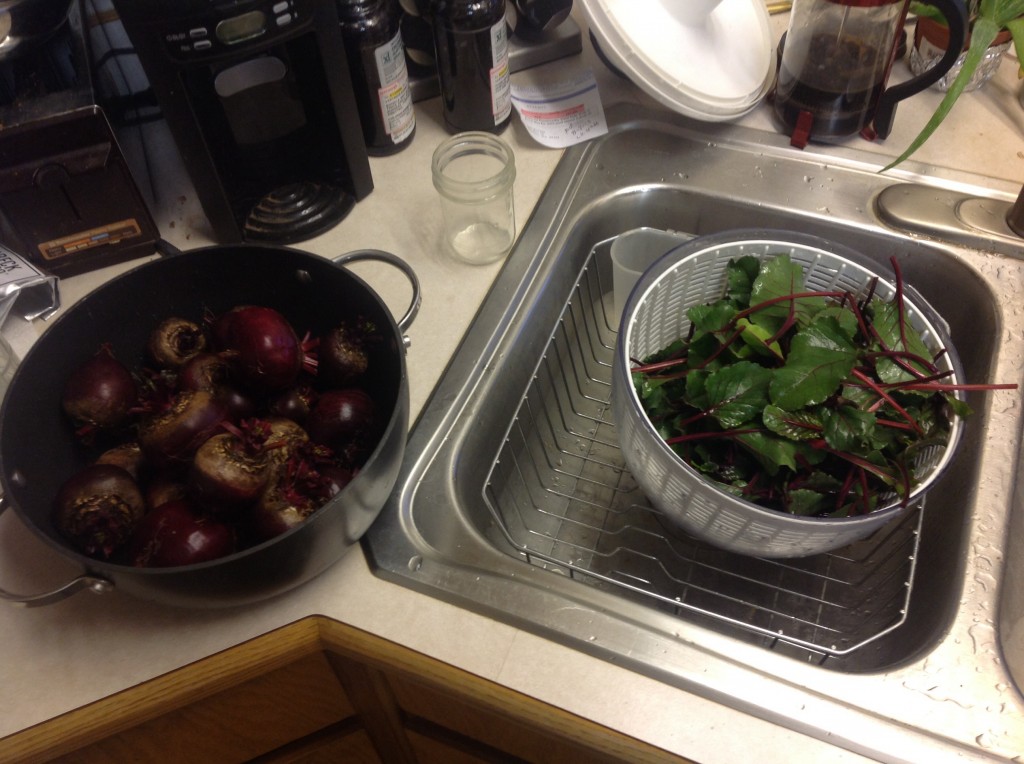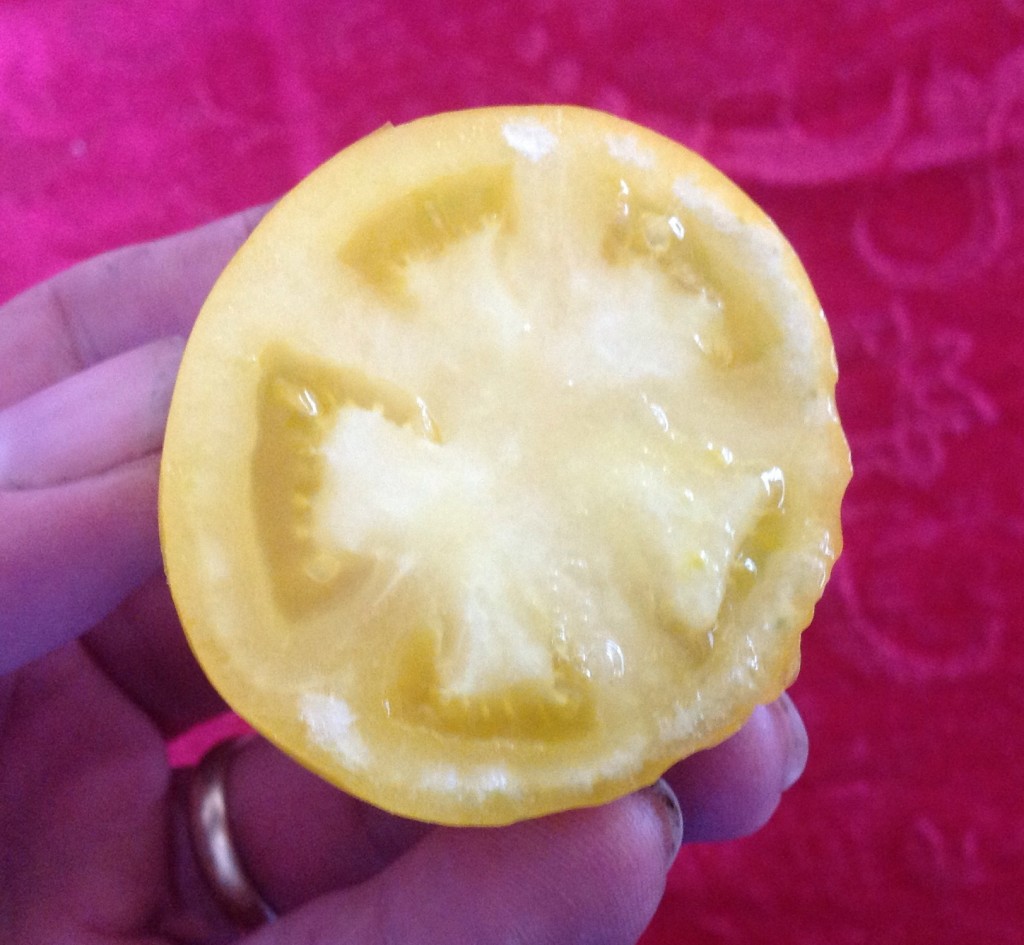So rather than try to talk about it; here’s a pickled egg.
The color comes from beet juice in the pickling solution. The eggs are boiled and peeled, and after a few weeks in the fridge in the solution, the color permeates the white, and you can see that it’s already started into the yoke.
Here’s the beet prep from last October;

We use the greens in salad and whatnot all summer. In the fall they get kinda tough, but I keep them, either blanched and frozen, or pickled, as a green for use all winter.
Here’s a 19th century cider mill I rebuilt in the 1970s and again just a few years ago;

We make between around 90 and 150 gallons per year all told, using apples I pick at a local orchard. McIntosh and Liberty apples make my favorite sweet (as opposed to hard) cider. The real serious producers will blend juices from different varieties, including crab apples, to get the flavor they want, but straight Mac is usually just right as it is. You can’t find cider like this in stores, but rarely, and then it costs eight or nine dollars a gallon. I don’t get it. But it doesn’t matter if you make your own.
Here’s some square dowel joinery I was doing for another antique cider mill I have in process;

I won’t discuss how it’s done because I don’t know how. I just had to improvise using the limited tools on hand at the time.
And last, here’s a tomato from my garden;
They call it the “Taxi” for the obvious reason. They’re delicious too, and I suppose any ripe tomato right off the vine is vastly superior to any tomato that’s been picked for shipping. The deer got most of my tomatoes this year, but I got revenge this hunting season. Now I have vegetables and venison in the freezer. Life is good


Nice job on the press rebuild.
Few quick questions: what size jugs do you put your cider in? Where did you get them? Do you hot water bath to pasteurize?
We have a press similar to yours and put up a bit of cider depending on the year and apple crop. But canning it in quart jars is a pain.
We use mostly one gallon plastic jugs. You can save them up (though if they’ve contained milk you have to be extremely thorough in washing them or they’ll stink later) or you can buy them new at some supermarkets where they sell them for use in bottling water. Half gallon jugs, from commercial fruit juice, are handy for giving away to a single person who typically won’t get through a whole gallon before it starts to turn.
I don’t pasteurize, but put it straight off the press into a dedicated freezer I got used for fifty bucks. If I’m going to make hard cider I’ll pasteurize, because otherwise your beautiful, bottled hard cider can turn to vinegar. If you’re going to drink it right away it doesn’t matter- just use it raw.
Canning cider makes a lot of sense, however, if you want to store it sweet (un-fermented) without electricity. In that case I’d get some half gallon Mason jars. Then just water bath them as with canning fruit. The Tattler reusable canning lids will not color the flavor, and of course you can use them for several seasons.
You can find books on cider making if you poke around on line, in which you can learn the many and varied ways cider was made and stored in the 19th century and earlier, back when cider was an important commodity. Lots of good stuff there. Lehmans is a good source, as well as for canning supplies.
I’m normally not successful at it, but I shoot for having enough cider that we can have it all year, while giving some away here and there. This time around I still had cider left from the previous year when we started pressing this year’s harvest. I think that was a first.
If I made about twice as much as normal, I’d be able to put away a bunch of hard cider in addition to the sweet. I do make a little bit of hard, but I don’t want it to cut into the supply of sweet cider by too much.
If you pasteurize, take it up to no more than about 150 degrees F or you’ll destroy the flavor. A brewing thermometer of the floating type works well here. Use a good “flavor transparent” yeast such Safale US-05 or S-04, and you get more of the real flavor of the apple coming through. I think yeast flavor coloration in one of the “problems” I have with some of the commercial junk. The other problem MAY be that cider making has largely become a way to use up apples that would otherwise be thrown away or used as animal feed. It’s trash. After secondary fermentation you can prime it as with beer, bottle it and end up with a sparkling hard cider that’s better by far than ANYTHING I’ve found commercially. If you want a really impressive result, do the champaign style sediment removal process. I did that once, and it was like drinking regular champaign but with a hint of Apple. That’ll keep for years and maintain its delicate flavor because it’s not siting on yeast sediment. The EZ Topper, flip top bottles are excellent as a re-usable bottle system. I keep several cases of the one liter size. They’re also available from the brewer supply houses.
BTW I pick windfalls at the orchard, and we just wash them real well. That’s it, then straight through the cider mill and into the freezer. I’ve been making cider this way since 1977 and it hasn’t killed me yet. Not even once. Back before we started picking from an orchard, we used windfalls off our largely untended trees at home. Full of worms. No problem, and the cider was absolutely wonderful. I got hooked on it back then you see.
For many years lately, we’ve put on a large cider making party at my brother’s house. The following weekend I’ll make it at home so I can be stingy and keep it all.
Oh, this is very important if you’re freezing cider; do NOT full the jugs all the way, or you’ll get sticky goo oozing out all over your freezer as the cider expands from freezing. Leave at least two or three inches headspace at the top, and leave them fully upright until they’re fully frozen and stabilized. Not much more than about three quarts to be safe in a one gallon jug for example.
Revenge is a dish best served with roasted root vegetables and a good red wine.
Time to add some chickens to your garden and orchard.
http://i559.photobucket.com/albums/ss31/Bert2368/photo-139.jpg
They’ll take care of most any leftovers from the garden, orchard and kitchen. Not to mention bugs… And the eggs are WAY better than store bought.